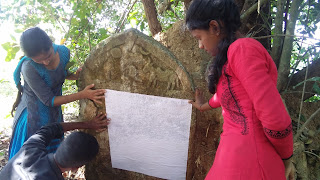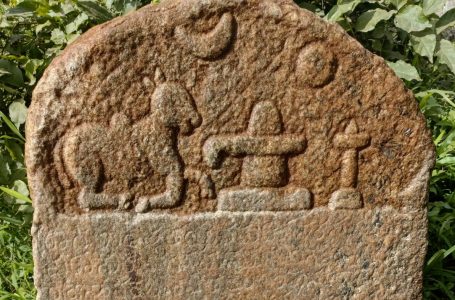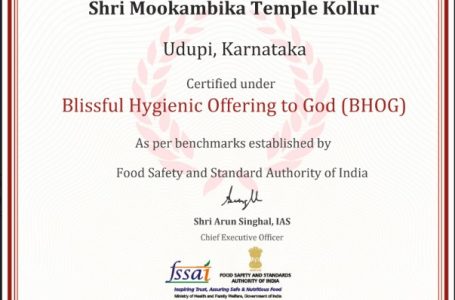Inscription reveals a strong hostile power against Vijayanagara Emperors in Karnataka coast

 |
| Prof Murugeshi and his students copying the inscription |
Udupi: Did the imperial forces of the Vijayanagara Kingdom face tough resistance in the coastal Karnataka?
Yes according to a new inscription found near Kollur.
An inscription of historical interest that might help in throwing more light on the tough fight put forth by the independent rulers of Kollur in Udupi district against the imperial forces of the Vijayanagara Kingdom has been discovered at Kollur village.
Kolluru which is famous for Sri Mookambika Temple is a prominent center of Shakthi worship in India and is situated about 75 kms from Udupi.
Kollur must have had strategical importance, as it is situated on the ancient route connecting coastal and Malnad region. Thus the fort there must be a bone of contention between the rulers.
Prof T Murugeshi, Associate Professor, Ancient History and Archaeology, MSRS College, Shirva who discovered the inscription dating back to Saka year 1290, Kilaka Samvat (1368 AD) declares that the inscription points at the strong fight put forth by the local rulers against the Vijayanagara Rulers.
The inscription was found at Baradakallu Bole in Kadali area, near Mahalingeshwara temple of Iduru-Kunjadi Village in Kundapura taluk. The inscription belongs to the Sangama Ruler Bukka I of Vijayanagar Empire.
“The epigraph records the siege of Kollur Fort. It states that Hanneredu (twelve) Yakkala (tenents) baliyavaru, Nada Nalvaru, (four officials of Nadu) and Senabova (a Village Official) Tippa laid seize to the fort of Kolluru and in that fight, a soldier named Kadada Mutta was martyred. As a mark of respect, Goparasa Odeya, the Governor of Barakuru Rajya (Barakuru was the regional Headquarters of Northern part of the coastal Karnataka) made a land grant (Manya) to the family members of Kadada Mutta,” Prof T Murugeshi says.
“I believe this inscription is of great importance in local history. It shows that though the Vijayanagara Kingdom was a mighty imperial force of South India by 1368, it faced a
strong standoff at Kollur. Fighting must have been difficult in the Malnad-Coastal belt for the Vijayanagara rulers. Considering the land grand, it looks like that the battle must be of great importance,” he feels.
“In the inscription, we do not get any details about the reason for the siege, the results and against whom was it was fought. But, an inscription dating back to 1377 discovered earlier from the nearby village Uppunda has come to our help. It has mentioned an independent King Katarasa, an associate of the King Kolarasa and an official Anna Senabova ruling in and around Kollur as contemporaries to Vijayanagar. We do not know much about them. But if the newly discovered inscription is read with the Uppunda inscription then we can conclude that the Vijayanagara Kingdom had fought with Katarasa and his subordinate Kolarasa. It looks like local independent rulers fought several years against the Emperors of Vijayanagara. It was only in 1480 AD Kolluru came completely under the control of Vijayanagara Kingdom,” he added.
Yes according to a new inscription found near Kollur.
An inscription of historical interest that might help in throwing more light on the tough fight put forth by the independent rulers of Kollur in Udupi district against the imperial forces of the Vijayanagara Kingdom has been discovered at Kollur village.
Kolluru which is famous for Sri Mookambika Temple is a prominent center of Shakthi worship in India and is situated about 75 kms from Udupi.
Kollur must have had strategical importance, as it is situated on the ancient route connecting coastal and Malnad region. Thus the fort there must be a bone of contention between the rulers.
Prof T Murugeshi, Associate Professor, Ancient History and Archaeology, MSRS College, Shirva who discovered the inscription dating back to Saka year 1290, Kilaka Samvat (1368 AD) declares that the inscription points at the strong fight put forth by the local rulers against the Vijayanagara Rulers.
The inscription was found at Baradakallu Bole in Kadali area, near Mahalingeshwara temple of Iduru-Kunjadi Village in Kundapura taluk. The inscription belongs to the Sangama Ruler Bukka I of Vijayanagar Empire.
“The epigraph records the siege of Kollur Fort. It states that Hanneredu (twelve) Yakkala (tenents) baliyavaru, Nada Nalvaru, (four officials of Nadu) and Senabova (a Village Official) Tippa laid seize to the fort of Kolluru and in that fight, a soldier named Kadada Mutta was martyred. As a mark of respect, Goparasa Odeya, the Governor of Barakuru Rajya (Barakuru was the regional Headquarters of Northern part of the coastal Karnataka) made a land grant (Manya) to the family members of Kadada Mutta,” Prof T Murugeshi says.
“I believe this inscription is of great importance in local history. It shows that though the Vijayanagara Kingdom was a mighty imperial force of South India by 1368, it faced a
strong standoff at Kollur. Fighting must have been difficult in the Malnad-Coastal belt for the Vijayanagara rulers. Considering the land grand, it looks like that the battle must be of great importance,” he feels.
“In the inscription, we do not get any details about the reason for the siege, the results and against whom was it was fought. But, an inscription dating back to 1377 discovered earlier from the nearby village Uppunda has come to our help. It has mentioned an independent King Katarasa, an associate of the King Kolarasa and an official Anna Senabova ruling in and around Kollur as contemporaries to Vijayanagar. We do not know much about them. But if the newly discovered inscription is read with the Uppunda inscription then we can conclude that the Vijayanagara Kingdom had fought with Katarasa and his subordinate Kolarasa. It looks like local independent rulers fought several years against the Emperors of Vijayanagara. It was only in 1480 AD Kolluru came completely under the control of Vijayanagara Kingdom,” he added.





